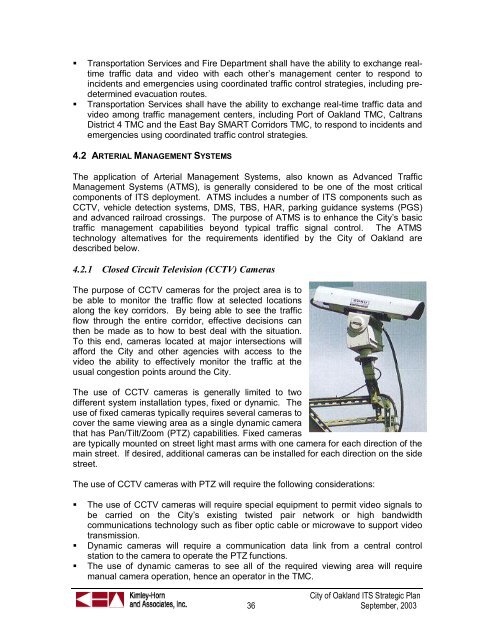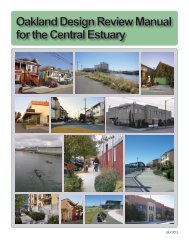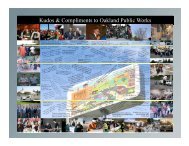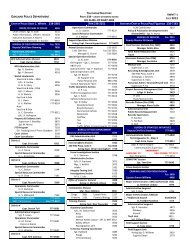Intelligent Transportation Systems - City of Oakland
Intelligent Transportation Systems - City of Oakland
Intelligent Transportation Systems - City of Oakland
You also want an ePaper? Increase the reach of your titles
YUMPU automatically turns print PDFs into web optimized ePapers that Google loves.
• <strong>Transportation</strong> Services and Fire Department shall have the ability to exchange realtime<br />
traffic data and video with each other’s management center to respond to<br />
incidents and emergencies using coordinated traffic control strategies, including predetermined<br />
evacuation routes.<br />
• <strong>Transportation</strong> Services shall have the ability to exchange real-time traffic data and<br />
video among traffic management centers, including Port <strong>of</strong> <strong>Oakland</strong> TMC, Caltrans<br />
District 4 TMC and the East Bay SMART Corridors TMC, to respond to incidents and<br />
emergencies using coordinated traffic control strategies.<br />
4.2 ARTERIAL MANAGEMENT SYSTEMS<br />
The application <strong>of</strong> Arterial Management <strong>Systems</strong>, also known as Advanced Traffic<br />
Management <strong>Systems</strong> (ATMS), is generally considered to be one <strong>of</strong> the most critical<br />
components <strong>of</strong> ITS deployment. ATMS includes a number <strong>of</strong> ITS components such as<br />
CCTV, vehicle detection systems, DMS, TBS, HAR, parking guidance systems (PGS)<br />
and advanced railroad crossings. The purpose <strong>of</strong> ATMS is to enhance the <strong>City</strong>’s basic<br />
traffic management capabilities beyond typical traffic signal control. The ATMS<br />
technology alternatives for the requirements identified by the <strong>City</strong> <strong>of</strong> <strong>Oakland</strong> are<br />
described below.<br />
4.2.1 Closed Circuit Television (CCTV) Cameras<br />
The purpose <strong>of</strong> CCTV cameras for the project area is to<br />
be able to monitor the traffic flow at selected locations<br />
along the key corridors. By being able to see the traffic<br />
flow through the entire corridor, effective decisions can<br />
then be made as to how to best deal with the situation.<br />
To this end, cameras located at major intersections will<br />
afford the <strong>City</strong> and other agencies with access to the<br />
video the ability to effectively monitor the traffic at the<br />
usual congestion points around the <strong>City</strong>.<br />
The use <strong>of</strong> CCTV cameras is generally limited to two<br />
different system installation types, fixed or dynamic. The<br />
use <strong>of</strong> fixed cameras typically requires several cameras to<br />
cover the same viewing area as a single dynamic camera<br />
that has Pan/Tilt/Zoom (PTZ) capabilities. Fixed cameras<br />
are typically mounted on street light mast arms with one camera for each direction <strong>of</strong> the<br />
main street. If desired, additional cameras can be installed for each direction on the side<br />
street.<br />
The use <strong>of</strong> CCTV cameras with PTZ will require the following considerations:<br />
• The use <strong>of</strong> CCTV cameras will require special equipment to permit video signals to<br />
be carried on the <strong>City</strong>’s existing twisted pair network or high bandwidth<br />
communications technology such as fiber optic cable or microwave to support video<br />
transmission.<br />
• Dynamic cameras will require a communication data link from a central control<br />
station to the camera to operate the PTZ functions.<br />
• The use <strong>of</strong> dynamic cameras to see all <strong>of</strong> the required viewing area will require<br />
manual camera operation, hence an operator in the TMC.<br />
<strong>City</strong> <strong>of</strong> <strong>Oakland</strong> ITS Strategic Plan<br />
36 September, 2003
















